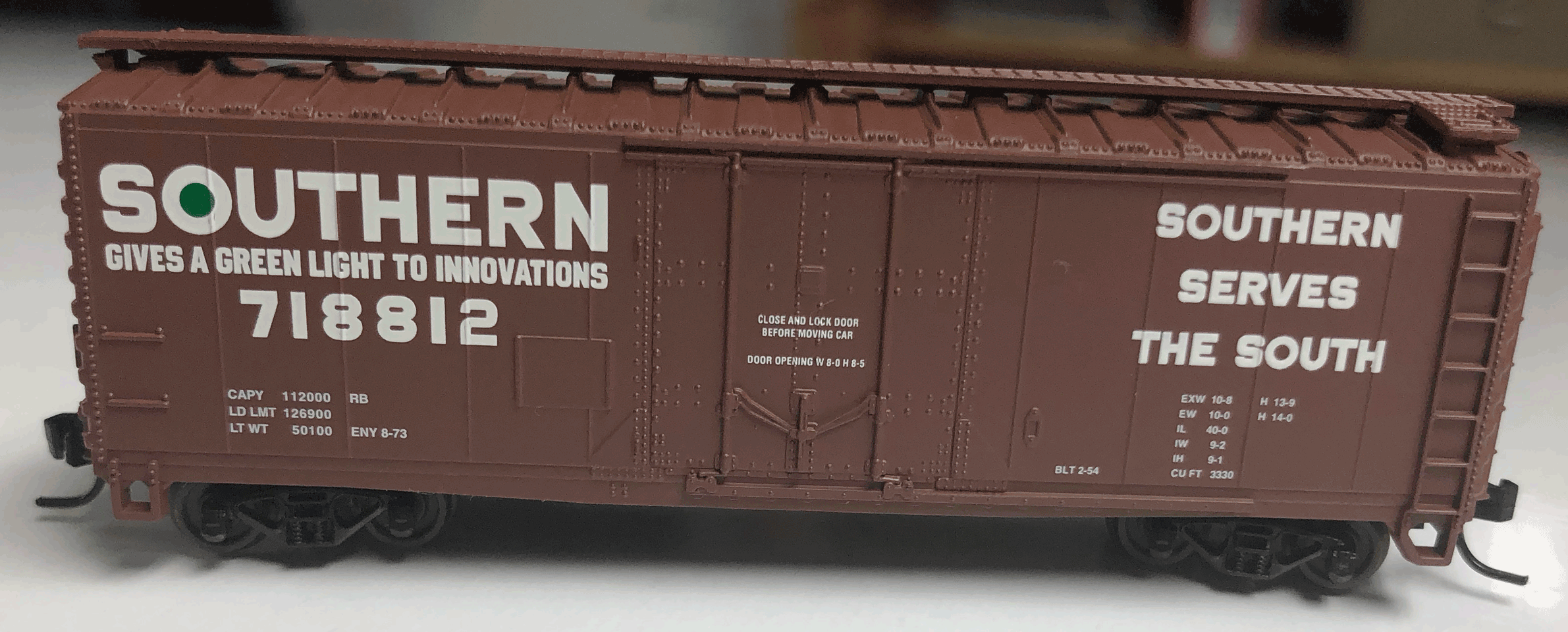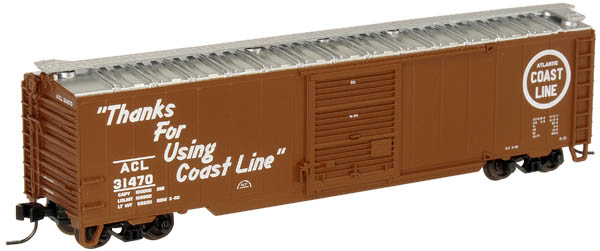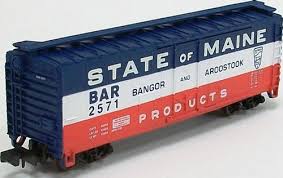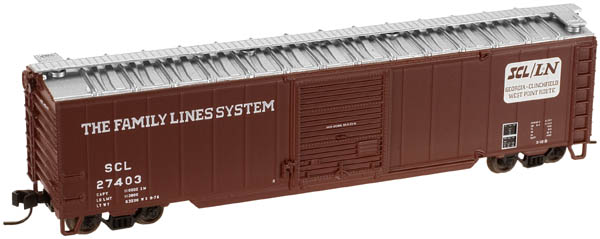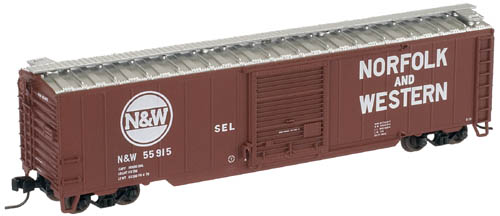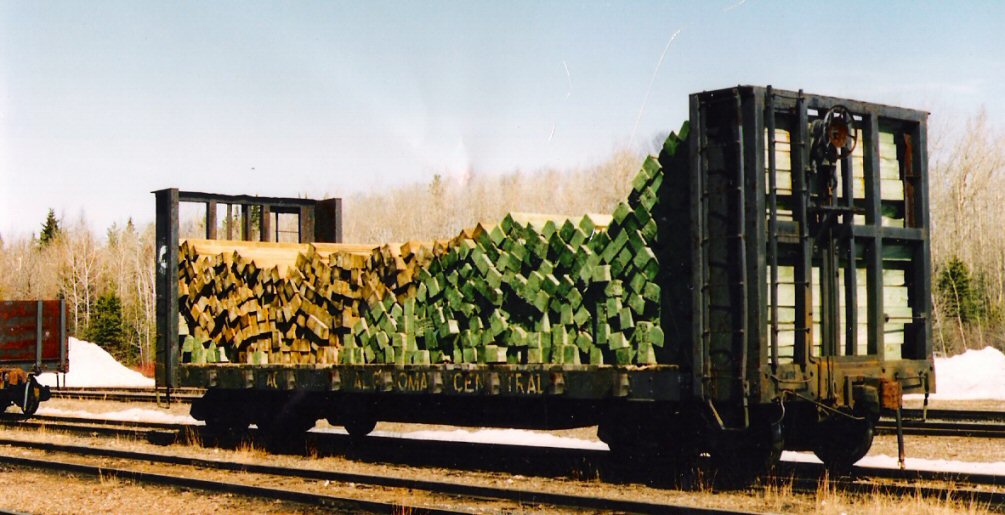Model Information: This is one of Atlas' Chinese-made toolings. It served as the replacement for the earlier Roco-made bulkhead flatcars from the 1960s and 1970s. This model is somewhat more detailed than the earlier Roco model It first appears in the Atlas 2000 catalog with two undecorated versions (open vs closed ends) and six different road names, each with multiple numbers. The price for the decorated version in 2000 was $13.95 and $9.95 for the two undecorated models.
Prototype History: Pulpwood is not a specific type of wood, but actually tree limbs that are cut to a specified length, then turned into wood pulp and used in the paper industry. Early paper making had the trees near the paper plant. As timber resources were diminished, the need for transporting pulpwood began to rise. Railroads were seen as an efficient method of transporting pulpwood. Pulpwood in the Southeast and Northeast is generally cut into four-foot or less lengths and loaded onto "V-deck" bulkhead flat cars.
In the early 1950s General Steel Castings, produced a "V-deck" design.
Another notable manufacturer of pulpwood flat cars was the Southern Iron & Equipment Company (SIECO) that manufactured this type of car in the 1960s and 1970s, with over 800 delivered in the early 1979’s to the Southern Railway, alone.
In the early 1950s General Steel Castings, produced a "V-deck" design.
Another notable manufacturer of pulpwood flat cars was the Southern Iron & Equipment Company (SIECO) that manufactured this type of car in the 1960s and 1970s, with over 800 delivered in the early 1979’s to the Southern Railway, alone.
Road Name History: The Louisville and Nashville Railroad (reporting mark LN), commonly called the L&N, was a Class I railroad that operated freight and passenger services in the southeast United States.
Chartered by the Commonwealth of Kentucky in 1850, the road grew into one of the great success stories of American business. Operating under one name continuously for 132 years, it survived civil war and economic depression and several waves of social and technological change. Under Milton H. Smith, president of the company for thirty years, the L&N grew from a road with less than three hundred miles (480 km) of track to a 6,000-mile (9,700 km) system serving thirteen states. As one of the premier Southern railroads, the L&N extended its reach far beyond its namesake cities, stretching to St. Louis, Memphis, Atlanta, and New Orleans. The railroad was economically strong throughout its lifetime, operating both freight and passenger trains in a manner that earned it the nickname, "The Old Reliable."
Growth of the railroad continued until its purchase and the tumultuous rail consolidations of the 1980s which led to continual successors. By the end of 1970, L&N operated 6,063 miles (9,757 km) of road on 10,051 miles (16,176 km) of track, not including the Carrollton Railroad.
In 1971 the Seaboard Coast Line Railroad, successor to the Atlantic Coast Line Railroad, purchased the remainder of the L&N shares it did not already own, and the company became a subsidiary. By 1982 the railroad industry was consolidating quickly, and the Seaboard Coast Line absorbed the Louisville & Nashville Railroad entirely. Then in 1986, the Seaboard System merged with the C&O and B&O and the new combined system was known as the Chessie System. Soon after the combined company became CSX Transportation (CSX), which now owns and operates all of the former Louisville and Nashville lines.
Read more on Wikipedia.
Chartered by the Commonwealth of Kentucky in 1850, the road grew into one of the great success stories of American business. Operating under one name continuously for 132 years, it survived civil war and economic depression and several waves of social and technological change. Under Milton H. Smith, president of the company for thirty years, the L&N grew from a road with less than three hundred miles (480 km) of track to a 6,000-mile (9,700 km) system serving thirteen states. As one of the premier Southern railroads, the L&N extended its reach far beyond its namesake cities, stretching to St. Louis, Memphis, Atlanta, and New Orleans. The railroad was economically strong throughout its lifetime, operating both freight and passenger trains in a manner that earned it the nickname, "The Old Reliable."
Growth of the railroad continued until its purchase and the tumultuous rail consolidations of the 1980s which led to continual successors. By the end of 1970, L&N operated 6,063 miles (9,757 km) of road on 10,051 miles (16,176 km) of track, not including the Carrollton Railroad.
In 1971 the Seaboard Coast Line Railroad, successor to the Atlantic Coast Line Railroad, purchased the remainder of the L&N shares it did not already own, and the company became a subsidiary. By 1982 the railroad industry was consolidating quickly, and the Seaboard Coast Line absorbed the Louisville & Nashville Railroad entirely. Then in 1986, the Seaboard System merged with the C&O and B&O and the new combined system was known as the Chessie System. Soon after the combined company became CSX Transportation (CSX), which now owns and operates all of the former Louisville and Nashville lines.
Read more on Wikipedia.
Brand/Importer Information: In 1924 Stephan Schaffan, Sr. founded the Atlas Tool Company in Newark, New Jersey. In 1933 his son, Stephan Schaffan, Jr., came to work for his father at the age of sixteen. Steve Jr. built model airplanes as a hobby and frequented a local hobby shop. Being an enterprising young man, he would often ask the owner if there was anything he could do to earn some extra spending money. Tired of listening to his requests, the hobby-store owner threw some model railroad track parts his way and said, "Here, see if you can improve on this".
In those days, railroad modelers had to assemble and build everything from scratch. Steve Jr. created a "switch kit" which sold so well, that the entire family worked on them in the basement at night, while doing business as usual in the machine shop during the day.
Subsequently, Steve Jr. engineered the stapling of rail to fiber track, along with inventing the first practical rail joiner and pre-assembled turnouts and flexible track. All of these products, and more, helped to popularize model railroading and assisted in the creation of a mass-market hobby. The budding entrepreneur quickly outgrew the limitations of a basement and small garage operation. Realizing they could actually make a living selling track and related products, Steve and his father had the first factory built in Hillside, New Jersey at 413 Florence Avenue in 1947. On September 30, 1949, the Atlas Tool Company was officially incorporated as a New Jersey company.
In 1985, Steve was honored posthumously for his inventions by the Model Railroad Industry Association and was inducted into the Model Railroad Industry Hall of Fame in Baltimore, Maryland. In addition, Steve was nominated and entered into the National Model Railroad Association Pioneers of Model Railroading in 1995.
In the early 1990s, the Atlas Tool Company changed its name to Atlas Model Railroad Company, Inc.
In those days, railroad modelers had to assemble and build everything from scratch. Steve Jr. created a "switch kit" which sold so well, that the entire family worked on them in the basement at night, while doing business as usual in the machine shop during the day.
Subsequently, Steve Jr. engineered the stapling of rail to fiber track, along with inventing the first practical rail joiner and pre-assembled turnouts and flexible track. All of these products, and more, helped to popularize model railroading and assisted in the creation of a mass-market hobby. The budding entrepreneur quickly outgrew the limitations of a basement and small garage operation. Realizing they could actually make a living selling track and related products, Steve and his father had the first factory built in Hillside, New Jersey at 413 Florence Avenue in 1947. On September 30, 1949, the Atlas Tool Company was officially incorporated as a New Jersey company.
In 1985, Steve was honored posthumously for his inventions by the Model Railroad Industry Association and was inducted into the Model Railroad Industry Hall of Fame in Baltimore, Maryland. In addition, Steve was nominated and entered into the National Model Railroad Association Pioneers of Model Railroading in 1995.
In the early 1990s, the Atlas Tool Company changed its name to Atlas Model Railroad Company, Inc.
Item created by: gdm on 2017-08-26 10:01:24
If you see errors or missing data in this entry, please feel free to log in and edit it. Anyone with a Gmail account can log in instantly.
If you see errors or missing data in this entry, please feel free to log in and edit it. Anyone with a Gmail account can log in instantly.






